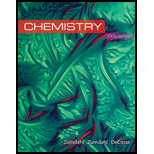
Concept explainers
(a)
Interpretation: It is given that, nitrogen reacts with hydrogen gas (in a container) to produce ammonia gas. The volume of this mixture and total pressure is given. The partial pressure and mole fraction of ammonia in a container during completion of reaction is to be calculated. The volume of container during the completion of reaction is to be calculated.
Concept introduction: The volume is calculated using
The mole fraction of ammonia is calculated using the formula,
To determine: The partial pressure of ammonia in a container during completion of reaction.
(b)
Interpretation: It is given that, nitrogen reacts with hydrogen gas (in a container) to produce ammonia gas. The volume of this mixture and total pressure is given. The partial pressure and mole fraction of ammonia in a container during completion of reaction is to be calculated. The volume of container during the completion of reaction is to be calculated.
Concept introduction: The volume is calculated using ideal
The mole fraction of ammonia is calculated using the formula,
To determine: The mole fraction of ammonia in a container during completion of reaction.
(c)
Interpretation: It is given that, nitrogen reacts with hydrogen gas (in a container) to produce ammonia gas. The volume of this mixture and total pressure is given. The partial pressure and mole fraction of ammonia in a container during completion of reaction is to be calculated. The volume of container during the completion of reaction is to be calculated.
Concept introduction: The volume is calculated using ideal gas law,
The mole fraction of ammonia is calculated using the formula,
To determine: The volume of container during the completion of reaction.
Trending nowThis is a popular solution!
Learn your wayIncludes step-by-step video

Chapter 20 Solutions
OWLv2 with MindTap Reader, 4 terms (24 months) Printed Access Card for Zumdahl/Zumdahl/DeCoste’s Chemistry, 10th Edition
- How many chiral carbons are in the molecule? OH F CI Brarrow_forwardA mixture of three compounds Phen-A, Acet-B and Rin-C was analyzed using TLC with 1:9 ethanol: hexane as the mobile phase. The TLC plate showed three spots of R, 0.1 and 0.2 and 0.3. Which of the three compounds (Phen-A; Acet-B or Rin-C) would have the highest (Blank 1), middle (Blank 2) and lowest (Blank 3) spot respectively? 0 CH: 0 CH, 0 H.C OH H.CN OH Acet-B Rin-C phen-A A A <arrow_forwardHow many chiral carbons are in the molecule? Farrow_forward
 ChemistryChemistryISBN:9781305957404Author:Steven S. Zumdahl, Susan A. Zumdahl, Donald J. DeCostePublisher:Cengage Learning
ChemistryChemistryISBN:9781305957404Author:Steven S. Zumdahl, Susan A. Zumdahl, Donald J. DeCostePublisher:Cengage Learning Chemistry: An Atoms First ApproachChemistryISBN:9781305079243Author:Steven S. Zumdahl, Susan A. ZumdahlPublisher:Cengage Learning
Chemistry: An Atoms First ApproachChemistryISBN:9781305079243Author:Steven S. Zumdahl, Susan A. ZumdahlPublisher:Cengage Learning
 Chemistry for Engineering StudentsChemistryISBN:9781337398909Author:Lawrence S. Brown, Tom HolmePublisher:Cengage Learning
Chemistry for Engineering StudentsChemistryISBN:9781337398909Author:Lawrence S. Brown, Tom HolmePublisher:Cengage Learning Chemistry: The Molecular ScienceChemistryISBN:9781285199047Author:John W. Moore, Conrad L. StanitskiPublisher:Cengage Learning
Chemistry: The Molecular ScienceChemistryISBN:9781285199047Author:John W. Moore, Conrad L. StanitskiPublisher:Cengage Learning Chemistry for Engineering StudentsChemistryISBN:9781285199023Author:Lawrence S. Brown, Tom HolmePublisher:Cengage Learning
Chemistry for Engineering StudentsChemistryISBN:9781285199023Author:Lawrence S. Brown, Tom HolmePublisher:Cengage Learning





